
Felidae is a family of mammals in the order Carnivora, colloquially referred to as cats, and constitutes a clade. A member of this family is also called a felid. The term "cat" refers both to felids in general and specifically to the domestic cat.

Hugh's hedgehog, also sometimes referred to as the central Chinese hedgehog, is native to central China and Manchuria. It prefers open areas of dry steppe, but can be found in shrubland and forests. It is known to look for food even in daytime on rainy days.

Leopardus is a genus of spotted small cats native to Central and South America, with one species extending into the southern United States.. The genus is considered the oldest branch of a lineage of small cats that crossed into the Americas, with the genera Lynx and Puma being later branches of the same group. The largest Leopardus species is the ocelot, and the kodkod is the smallest cat in the Americas. The margay is highly adapted to arboreal life.

Pantherinae is a subfamily within the family Felidae, which was named and first described by Reginald Innes Pocock in 1917. The Pantherinae and the Felinae diverged from a common ancestor between 10.8 and 11.5 million years ago.
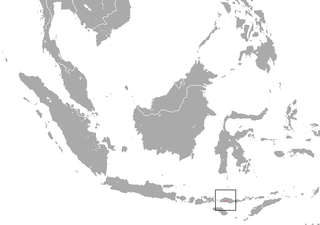
The Flores shrew is a white-toothed shrew found only on Flores Island, Indonesia. It is listed as a critically endangered species due to habitat loss and a restricted range.

The common punaré, Thrichomys apereoides, is a species of spiny rat endemic to Brazil.
The Bogotá grass mouse or Bogotá akodont, is a species of rodent in the family Cricetidae. It is found in the Andes eastern and central Colombia and northwestern Venezuela. Alavarado-Serrano and D'Elía (2013) have assigned the species to a new genus, Neomicroxus along with Neomicroxus latebricola.
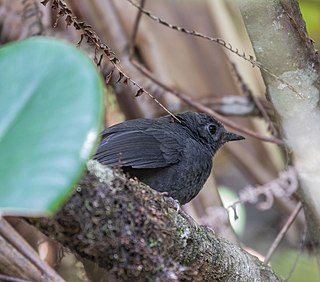
The brown-rumped tapaculo is a species of bird in the family Rhinocryptidae. It is endemic to Colombia. Its natural habitat is subtropical or tropical moist montane forests.

Herpestes is a genus within the mongoose family Herpestidae. It is the type genus of the family and comprises ten living species, with a number of subspecies, and one extinct species.
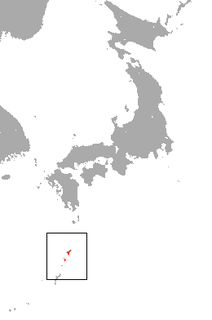
The Ryukyu shrew , also known as Orii's shrew is a species of mammal in the family Soricidae. It is endemic to Japan. It is threatened by habitat loss.

The Viverrinae represent the largest subfamily within the Viverridae comprising five genera, which are subdivided into 22 species native to Africa and Southeast Asia. This subfamily was denominated and first described by John Edward Gray in 1864.
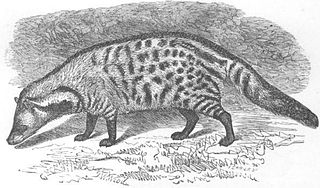
Viverra is a mammalian genus that was first nominated and described by Carl Linnaeus in 1758 as comprising several species including the large Indian civet. The genus was subordinated to the viverrid family by John Edward Gray in 1821.
Bat Conservation International (BCI) is an international nongovernmental organization working to conserve the world's bats and their habitats through conservation, education, and research efforts.

The highlands punaré, Thrichomys inermis, is a caviomorph rodent of South America from the spiny rat family. It is endemic to gallery forest, savanna and rocky outcrop habitats in Bahia State within the Caatinga ecoregion of eastern Brazil at elevations from 260 m to 1030 m. It sometimes nests and often takes refuge in crevices in rock formations, as means of both predator avoidance and moderating temperature extremes. The species tolerates a degree of habitat disturbance. Although hunted, it is considered common throughout its range. Its karyotype has 2n = 26 and FN = 48.

Thomasomys ucucha, also known as the ucucha thomasomys, is a rodent in the genus Thomasomys of the family Cricetidae. It is known only from high altitude forest and grassland habitats in the Cordillera Oriental of Ecuador. Seven other species of Thomasomys live in the same areas. First collected in 1903, T. ucucha was formally described as a new species in 2003 and most closely resembles T. hylophilus, which occurs further to the north. The species is listed as "vulnerable" in the IUCN Red List as a result of habitat destruction.
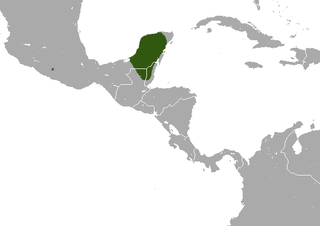
The Yucatan small-eared shrew is a species of mammal in the family Soricidae. It is mainly known from lowlands of Guatemala, Belize and Mexico's Yucatán Peninsula, where it has been found in dry scrubland and tropical dry forest at elevations below 100 m. It is threatened by deforestation.
The black brotula, also known as the black widow, is a species of viviparous brotula found in reefs of the western Atlantic Ocean where it occurs from the Bahamas in the north southwards to Brazil. This species grows to a length of 7.5 centimetres (3.0 in) TL. This species is the only known member of its genus.














